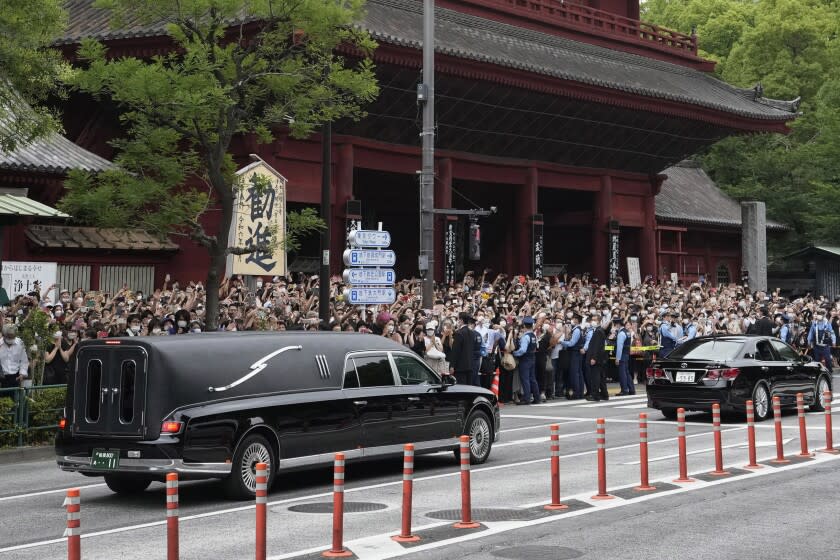Japan says its final goodbye to slain former leader Shinzo Abe

- Oops!Something went wrong.Please try again later.
- Oops!Something went wrong.Please try again later.
Japan bade its final goodbye to former Prime Minister Shinzo Abe on Tuesday at a family funeral at a temple days after his assassination shocked the nation.
Abe, the country's longest-serving prime minister, who remained influential even after he stepped down two years ago, was gunned down Friday during a campaign speech in the western city of Nara.
Hundreds of people, some in dark formal suits, filled pedestrian areas outside the Zojoji temple in downtown Tokyo to bid farewell to Abe, 67, whose nationalistic views drove the governing party's ultraconservative policies.
Mourners took photos and some called out “Abe san!” as a motorcade with the hearse carrying his body, accompanied by his widow, Akie Abe, slowly drove past the packed crowd.
“I believe there were many things he left unfinished as a politician,” public broadcaster NHK quoted Akie Abe as saying. “But he planted many seeds and I’m sure they will sprout.”
Abe’s longtime ally and mentor, Finance Minister Taro Aso, described him as “the most talented politician in postwar Japan, who raised Japan’s international profile.”
About 1,000 people, including Prime Minister Fumio Kishida and senior party leaders as well as foreign officials, attended the funeral at the temple.
Taiwanese Vice President Lai Ching-te also attended in a private capacity, Taiwan's Central News Agency reported, prompting a formal protest from China. Beijing considers Taiwan a breakaway province and objects to any expression of its independent political identity.
The hearse made a tour of Tokyo's main political headquarters of Nagata-cho, where Abe spent more than three decades since he was first elected in 1991. It then drove slowly past the headquarters of the ruling Liberal Democratic Party, where senior lawmakers stood outside and prayed, before heading to the prime minister's office, where Abe served two stints for a total of nearly a decade.
Kishida and his Cabinet members pressed their hands before their chests as they prayed and bowed to Abe's body before the hearse headed to a crematorium.
On Sunday, two days after Abe's death, the Liberal Democrats and their coalition partners won a landslide victory in the upper house, the less powerful chamber of Japan's bicameral parliament.
That could allow Kishida to govern uninterrupted until a scheduled election in 2025. But the loss of Abe also opened up a period of uncertainty for his party. Experts say a power struggle within the party faction that Abe led is certain and could affect Kishida's grip on power.
Kishida has stressed the importance of party unity after Abe's death.
Abe’s shooting shook a nation known as one of the world's safest, with some of its strictest gun laws. Gun violence in Japan is extremely rare.
The alleged gunman, Tetsyua Yamagami, was arrested on the spot Friday and is being detained at a local prosecutors’ office for further investigation. They can detain him for up to three weeks while deciding whether to press charges.
Police said Yamagami cited a rumored link between Abe and an organization that Yamagami hated as the motive for the killing. Media reports said that the organization was the Unification Church and that Yamagami disliked it because donations by his mother to the religious group had bankrupted his family.
The head of the Japanese branch of the South Korean-based church, known for its anti-Communist stance and mass weddings, confirmed Monday that Yamagami's mother was a member. He said Abe was not, but may have spoken at groups affiliated with the church.
Police this week inspected a building related to the church in Nara after the suspect told investigators that he had test-fired a homemade gun there the day before the assassination. They found several holes in the building believed to be bullet holes, NHK and other Japanese media reported.
On Tuesday, National Police Agency chief Itaru Nakamura said police failed to fulfill their responsibility to protect Abe. “I feel deep regret and shame,” he said. He told reporters that the agency will set up a task force to review guarding procedures.
Abe, the son of an earlier prime minister, became Japan's youngest leader in 2006 at age 52. He left after a year in office due to health reasons but returned to power in 2012.
He vowed to revitalize the nation and get its economy out of its deflationary doldrums with his “Abenomics” formula, which combines fiscal stimulus, monetary easing and structural reforms.
His long-cherished goals, shared by other ultra-conservatives, were to revise Japan's pacifist constitution, which was drafted by the United States after World War II, and to transform Japan's Self Defense Force into a full-fledged military.
Abe left office in 2020, citing a recurrence of the ulcerative colitis he'd had since he was a teenager.
This story originally appeared in Los Angeles Times.

